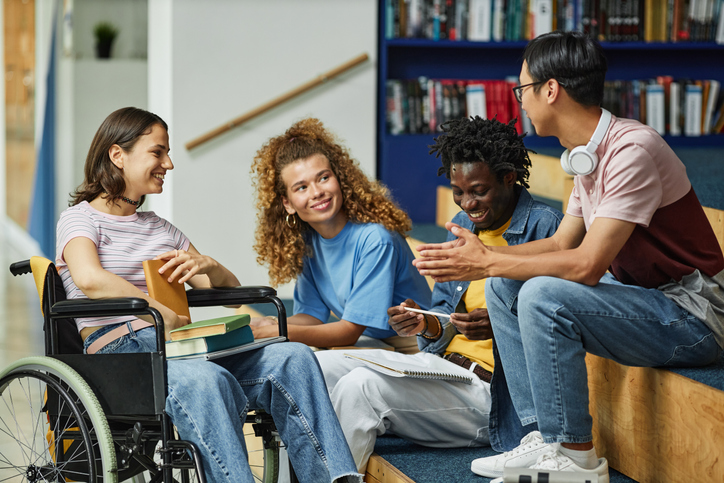Back in February of this year, a gunman opened fire at Michigan State University, killing three people and injuring five others, marking the 12th mass shooting to happen on a college campus in the US since the 1960s. The shooting also reflects a concerning rise in violence—specifically gun violence—happening across campuses throughout the US, taking place just three months after the 11th mass shooting on a college campus—in which three students were killed and at least two more were injured after a shooter opened fire on a bus at the University of Virginia—which took place just hours after four University of Idaho students were stabbed to death in their off-campus apartment.
This trend in violence, happening alongside a series of interconnected or compounded crises related to public health, racial injustice, growing inequality, social upheaval and polarization, rapid transformation, geopolitical conflicts, and economic and environmental instability, can have profoundly negative impacts on students; the plethora of research that has emerged in the wake of the COVID-19 pandemic says as much. As many as nine in 10 students say that their mental health was negatively impacted by the public health crisis, a sentiment corroborated by statistical increases in moderate to severe stress, depression, anxiety, and suicidality observed among this demographic. Dropout rates are continuing to climb even after the WHO officially declared an end to the pandemic, while enrollment rates struggle to keep pace. Meanwhile, as many as 80 percent of public institutions report “stunted behaviors and socioemotional development” in their students that includes a failure to keep up on assignments, failure to participate in class, failure to connect with peers, and above all, a failure to take care of themselves.
In fact, besides the immediate threats that such crises pose to students’ physical and mental health—by means of violence and threats to their safety, the dissolution of community and disconnection from social support, the death, destruction, or loss of resources they cause, and the trauma they inflict—they also contribute to long-term damages to students’ sense of self-efficacy, and thus to their ability to cope and persevere. This can be seen most obviously in the staunch rise in dropout rates paired with a plateau in enrollment; but it can also be observed within the context of the growing mental health crisis throughout college and university campuses, which includes a rise in substance abuse, reckless and oftentimes illicit behaviors, and the presence of a tense or disjointed social climate.
Serving as both the cause and consequence of such damage to students’ self-efficacy is their need to reassess their values, beliefs, ambitions, and future pathways in times of crisis, and how successful they are in readjusting and adapting to change. As many experts note, many students now find it nearly impossible to determine when, how, and whether they will pursue their goals for a degree, a career, a relationship, for financial independence, and become a self-sufficient and autonomous adult amidst a period of such ubiquitous instability and uncertainty. This, of course, is antithetical to the whole idea of higher education, in which students are empowered to pursue their dreams—effectively transforming their dreams into reality—and trusting that their dreams and their envisioned futures are attainable.
Thus, when it comes to supporting students through crises, the goal for institutions, then, becomes not only providing immediate health—specifically, mental health—support during and in response to crises, but fostering resilience so that they may thrive and flourish in their wake, and be well-equipped to handle future crises that are guaranteed to unfold (and at increasing rates). This requires providing students with more than just in-the-moment crisis support, specifically by leveraging psychoeducation and campus-wide trainings, peer support, and various wellness initiatives centered around enhancing students’ skills and adaptive coping mechanisms.
Importance of Resilience
As global social, cultural, political, economic, and environmental events become more and more interconnected, so, too, do higher ed institutions become more vulnerable, or rather, susceptible to various crisis events. Regardless of the nature of these events, according to American physicist and “futurist,” Herman Kahn, there are several key dimensions that all crises share that can be used to identify their presence on campus; namely, that a crisis:
- Threatens the goals, objectives, and ambitions of those involved
- Consists of a convergence of events that creates a new set of circumstances
- Produces uncertainties in assessing a situation and identifying alternatives for dealing with it
- Reduces one’s sense of control over events and their effects
To put it more plainly, a crisis event is an abrupt shift away from what was or has been (the past), toward an uncertain, undefined, and unknown future. Dismantling formal worldviews, habits, and routines, crises also result in the real or perceived loss of resources needed to cope with stress and maintain wellbeing. This in turn results in the loss of psychological resources—specifically, agency, self-efficacy, relatedness and belonging, among others—needed to self-actualize and reach one’s full potential (or believe that they can).
This is particularly burdensome for students who are in a “transitional phase” developmentally, socially, and professionally: already lacking in resources and an established social network, crises impede on students’ ability to withstand change, setbacks, or challenges, envision a way out of negative circumstances, explore their interests, and carve out their own path in life—opting instead for what’s easiest, safest, or most sustainable.
To rectify this, various studies have underlined the role that resilience plays in enhancing students’ academic success, their development, their ability to adapt and cope with life’s stressors, and above all, their wellbeing.
Far from a personality trait that many erroneously take it for, resilience can instead be understood as an amalgam of different skills essential for stress managing and healthy coping strategies, including (i) emotional intelligence and regulation; (ii) hope and optimism; (iii) trust and perseverance; (iv) vulnerability and openness; (v) compassion; and (vi) mindfulness—all of which students can employ to keep themselves tethered to the present with their head held high and their gaze turned toward the future, rather than getting caught up in their losses and longing for an irretrievable or unsustainable past. Resilience, according to some scholars, is the process through which students continually develop these skills, successfully managing through one crisis to the next in which the distress or disruption these events cause decrease over time.
It is for this reason that, beyond in-the-moment crisis support—which includes transparent communication to keep students informed as events unfold, counseling support for symptoms of stress (anxiety, depression, suicidality, etc.), emergency aid (food, clothes, shelter, money, where applicable), and more—a sustainable and robust crisis management plan for college and university campuses includes strategies for cultivating students’ resilience, so that when future crises emerge (which they will), institutions can shift gears faster and more efficiently, and suffer fewer damages each time.
Limitless Potential: Social vs. Individual Resilience
Still, resilience is not without its limitations, particularly in how it is most often conceptualized. As some scholars note, the emphasis on individual characteristics and solutions found throughout most present-day concepts of resilience, e.g., self-sufficiency, mindfulness, meditation, offers merely micro-level fixes to macro-level problems, creating a hostile environment in which victims are blamed and shamed for not being able to adapt despite enduring inequalities, gaps in resources and access to support, and a lack of organized, systemic change.
To that point, growing literature has underscored the value of community or social resilience in mitigating and ultimately reducing these pitfalls. As noted, sense of belonging, relatedness, and social support are essential to the processes of self-determination and self-actualization; so, too, are they requisite for resilience-building. As some scholars contend, resilience can perhaps be best understood as “the outcome from negotiations between individuals and their environments for the resources to define themselves as healthy amidst conditions collectively viewed as adverse;” the mobilization of cultural, institutional, and social resources produced by or associated with various groups of people; or the “creative recombination of resources, collective adaptation, or collective resistance.”
Through this conceptualization of resilience, it is recognized that the amount or quality of resources that one has access to in times of crisis is largely dependent on factors like socioeconomic status, geographical location, race or ethnicity, sexual orientation, and gender identity, in which white, straight, cis-gender upper-class students are the most advantaged, whereas marginalized (BIPOC, LGBTQIA+, ESL, international), working-class students are the least advantaged. By fostering a sense of community, collaboration, and connectedness across all student groups on campus, institutions can work to alleviate these long-standing disparities regarding the availability and accessibility of resources, all the while fostering strong social bonds and robust social networks that all students—regardless of background—specifically come to campus to build.
In fact, numerous studies have observed that when individuals feel a strong sense of connection to those around them, signs of resilience—including emotional intelligence, optimism, and self-confidence—are more prevalent. One study conducted among post-secondary students in particular found that students with both higher emotional intelligence (psychological resilience) and higher levels of social support were more likely to engage in positive, healthy coping strategies to deal with various stressors, whether academic, social, financial, or other. Moreover, survey data collected during the pandemic found that a greater number of friends and greater satisfaction with friend communication and social support during that time were directly associated with lower anxiety and depressive symptoms and greater social adaptability.
How to Build a Resilient Student Body
“If you only think through the lens of treatment—if you don’t complement treatment with the promotion of resilience and wellbeing—you’re part of the problem, not the solution” — Corey Keyes, Emory University Sociologist
When it comes to equipping students with the skills needed to build resilience—both individually and collectively—there are four key areas that experts emphasize:
- Self-awareness and self-care
- Self-reflection and regulation
- Self-efficacy and mastery
- Social engagement and enhancement
Thus, the framework for resilience-building strategies on campus begins with education, teaching students about the importance of core competencies, such as compassion, affirmation, vulnerability, help-seeking, reflection, and more, teaching them about the benefits of resilience, and coaching them on how they can seek to develop these skills; shifts to development, in which action-based strategies are deployed to prime and develop students’ skills; and ends with enhancement, in which students are empowered to connect, communicate, and collaborate with peers in order to practice and bounce their newfound skills off of each other, learning and growing as they do while also gaining multiple perspectives on cultural stressors and how to cope with them, as is essential for the fruition of social resilience.
Education
Given the setting for these interventions, it makes sense that campus leaders would aim to first educate students on the importance, purpose, and benefits of resilience, along with other health- and wellness-related topics. As students arrive to campus, they are also arriving at a point in their lives where they are—perhaps for the first time, or perhaps just more extensively and explicitly—being given the space, the freedom, and the opportunity to explore and form their own identities. With that comes having to figure out how to identify and fulfill their own needs, and more critically, how to do so in the face of challenges.
Unfortunately, as previously discussed, not all students arrive to campus at the same starting point when it comes to resilience, self-sufficiency, self-awareness, emotional intelligence, and general health literacy. For instance, many students may have grown up in homes or in communities where openly talking about their mental health or overall wellbeing was not encouraged or worse, not tolerated. Others might come from families that continually dismiss their feelings or from communities that lack mental health resources—all of which can stunt or impede on their emotional development: causing repression, dysregulation, projection, and many of the psychological and behavioral problems present across most campuses today, like depression and anxiety, suicidality, substance misuse, violence, harassment, and assault, as students fail to understand how to process, express, and cope with their emotions in a positive way.
That said, part of an effective (and equitable) resilience-building strategy will include campus-wide efforts to educate students on core competencies, ranging from the importance of exercise, quality sleep, and healthy eating; the importance of the mind-body connection, mindfulness, and awareness; the importance of self-confidence and self-efficacy in managing stress; and the importance of various psychological tools in the face of external stressors and how students may seek to develop them.
To illustrate the feasibility and effectiveness of such educational interventions, a recent study conducted among Indian college students had students participate in a two-week, two-session program aimed to expand upon their understanding of resilience and the factors involved in bolstering it. The first session prompted students to express their views and opinions regarding “resilience,” through questions like: “Do you look for creative ways to alter difficult situations?” and “Do you believe you can grow in positive ways by dealing with difficult situations?” with the goal of helping them to determine best strategies for coping through difficult situation; while the second session sought to nurture students’ skills in the areas of goal-setting, self-reflection, confronting failures, and positive self-talk by asking them to reflect on current priorities and how well they align with one’s satisfaction in life and distributing a pamphlet aimed at helping students’ discern how they can realign their priorities to bolster resilience—which included the development of a strong support system. In the end, the study concluded that the program was an effective way of promoting resilience and healthy coping skills among students.
And students aren’t the only ones in need of education. Studies show that when students build positive relationships with caring, supportive, and approachable professors, they demonstrate higher levels of resilience. Thus, an additional aim for campus leaders should be to train professors on the importance of trauma-informed pedagogy and teaching strategies, which includes the importance of compassion, active-listening, affirmation, personal vulnerability, transparency, and flexibility to support their mental health needs—especially during or following times of crisis, such as the pandemic or instances of school shootings, violence, or deaths. It is especially important that educators are trained on the importance of establishing and maintaining trust with students, making sure that they are transparent in that if something perilous is shared with them (e.g., suicidal comments, threats or allusions to self-harm), that they will have to report it, or making sure that they keep any and all promises they make, so that students perceive them as a first-point of contact to turn to in the event of a crisis or even a personal emergency.
While demand is certainly too high to rely solely on counseling and therapeutic support to help students cope with life’s stressors, investing in culturally competent and trauma-informed care providers, including counselors, coaches, and advisors, is still an effective and, arguably, necessary way to help students develop a better understanding of what their needs, hopes, wants, and aspirations are, and how they can fulfill them in healthy, positive ways. This may include exploring past traumas and the impacts that they have on their lives, their coping mechanisms, and their resilience today; breaking down what is and is not in their control; deconstructing negative thought patterns, separating emotion from fact, and destigmatizing mental health and help-seeking.
Development
Once students have access to various educational opportunities, leaders can then shift their focus toward interventions aimed at fostering students’ growth and skills development. This can also be considered the “priming” or “sharpening” stage, in which students are empowered to put their newfound skills or knowledge to practice. More importantly, these interventions should seek to help students set positive, attainable goals and adjust their priorities so that they are not completely sidelined in the event of a crisis.
Typically, this is often where interventions like mindfulness, meditation, yoga, and exercise come into play; ensuring that students are actively taking the steps to take care of themselves, are staying aware of their needs, and are managing their stress levels. Especially in the context of building resilience against stressful events, these interventions help students:
- Practice self-compassion, accepting mistakes, letting go of past errors, acknowledging their strengths, and trusting themselves and the process
- Keep a long-term perspective, developing realistic goals that they can work toward on a daily or long-term basis, anticipating and embracing change, and adopting a growth mindset (the linchpin to resilience)
- Maintain control of their lives, focusing on what they can do or change to improve their current situation, reflecting on which coping strategies are helpful and which aren’t, and taking decisive action rather than avoiding problems
- Find or make meaning through change, finding a way to continuously live out their core values amidst an ever-changing world
This is accomplished by constantly calling students’ attention to the present moment: discerning what can or needs to happen now versus what can wait until later. Studies show that when post-secondary students master the skill of mindfulness, they become more aware of multiple approaches to solving a problem, remain curious, open, and accepting of change, and present high levels of resilience; whereas those who struggle with this skill are more likely to fall into situations of helplessness, apathy, depression, or anxiety.
There are multiple routes through which campus leaders can encourage students to practice mindfulness and other resilient skills; chief among them including expressive writing and expressive arts therapy. At Penn State, for instance, students are offered tips on how to build and foster resilience, which includes setting aside time to reflect on how they can move toward goals (“What’s one thing I know I can accomplish today that helps me move in the direction I want to go to?”), adopt a growth mindset (“What can I learn from this? What can I take from this?”), increase their sense of control (“How am I managing my time? Is there a task that I can take off my to-do list? Is there a routine that I can stick to that will help me to feel in control of my day?”), embrace strengths (“What assets do I have that have gotten me this far? What strengths can I build upon?”), and boost their self-confidence and self-esteem (“When was the last time I made a good decision? A bad decision? What did I learn from these experiences? How did I cope with a past difficulty?”).
Among these tips include expressive writing exercises such as the Best Possible Self exercise, in which students are prompted to visualize a future, ideal self (and thus an ideal future), and describe in detail what that future life would look like, including accomplishments and achievements, attributes, possessions, and other conditions. In fact, studies have shown that positive writing interventions, which include diaries and gratitude journals, can enhance not only students’ sense of hope and optimism, but also their self-efficacy, self-mastery, and emotional regulation. This effect is explained by the broaden-and-build theory, which posits that broadened attention, i.e., paying attention to experiences that would have otherwise been overlooked, and broadened cognition—reflecting on, thinking, and writing about one’s mental experiences—triggers momentary thought-action repertoires that expand one’s cognitive flexibility, creativity, and thus transform negative emotions into positive psychological resources that can be leveraged to cope with stress.
As an alternative to writing therapy, expressive arts therapy has also been shown to be an effective way boost students’ self-efficacy, self-acceptance, problem-solving skills, and overall resilience. This is partly due to art’s ability to boost serotonin levels: the “happy hormone” responsible for helping an individual heal from physical trauma, sleep better, and regulate mood. Additionally, the process-oriented nature of most art projects reflects the idea that resilience itself is a process; something that can be bolstered and improved upon in time through practice.
To demonstrate the positive impact that arts interventions can have on students’ resilience, a case study conducted among Chinese post-secondary students had them participate in a four-session curriculum that integrated various forms of art therapy, which included music, dance, art, and drama. The first session revolved around music therapy aimed at teaching students how to regulate their breathing, relax the body, and alleviate physical symptoms of stress. The second session revolved around dance and movement therapy focused on strengthening students’ mind-body connection, self-awareness, and sense of control. The third session involved exploratory artistic work (e.g., paint, clay, crayons, collages) meant to bolster students’ emotional intelligence and regulation, self-confidence, communication skills, and optimism; while the fourth and final session engaged students’ problem-solving skills and creativity by prompting them to improvise a play based on a challenge or negative experience they might experience (e.g., isolation and uncertainty due to the pandemic) and how they might learn from and cope with the stress such an experience would cause using their strengths and the coping strategies that they’ve learned through the intervention.
By the end of the study, findings showed that the intervention significantly improved students’ self-efficacy, self-acceptance, and increased their competence in problem-solving, explicitly helping them to identify, analyze, and resolve problems by: (i) assessing the situation, (ii) determining the root cause(s) of the problem, (iii) imagining and determining feasible alternatives, and (iv) developing and executing an action plan.
Enhancement
Once students are offered multiple opportunities to nurture and develop various skills essential for a resilient campus, perhaps the most critical facet of a campus’ resilience-building strategy is making sure that students are given multiple opportunities for collaboration, connection, social engagement, networking, and peer community- and relationship-building. According to the ARCH Framework conceptualized by experts at Lesley University, it is in fact collaboration—with peers, professors, families, communities, and local agencies—through which campus leaders can work to bridge together students’ sense of support and self-regulation skills, and their sense of competence and confidence in their abilities and resources, so that they may thrive and improve their health and wellbeing.
As research suggests, the reason why collaboration is so paramount to students’ resilience is due to their need to find purpose and make meaning through times of crisis. It’s why students are so willing to organize or participate in marches and get involved in activism or volunteer work: they want to be changemakers—more than that, they’ve been raised by the mantra to be the change they wish to see in the world—and these are just some ways in which they achieve that aim. Thus, when it comes to cultivating resilience, not only is it important that students receive help, but also that they are able to offer help that makes a difference.
For instance, a recent study conducted among American college and university students during the pandemic discovered that all students—regardless of background—were “deeply concerned” with how to improve not just their personal wellbeing, but that of their family, friends, community, and society amidst a backdrop of three interconnected crises: (1) growing inequality and the “untenability of the American Dream;” (2) political polarization, and (3) social upheaval, including the racial reckoning that took place in the months following the onset of COVID. To combat such uncertainty and anxiety, survey findings showed that most students supported “choosing future career paths that benefit others,” as an alternative long-term strategy to “redefine criteria of achievement” and satisfaction, as over 80 percent of students said they have a positive view of ambition and success if it is “geared toward collective advancement,” indicated that “communal contribution” is a major protective factor for their mental health and wellbeing, and expressed an appreciation for things like empathy, cohesion, and common purpose.
Thus, to facilitate the development of mutually beneficial relationships and collective resilience on campus, many higher education institutions have already turned to initiatives such as mentor and ambassador programs, student clubs, organizations, and other peer-led interventions, and group counseling and workshop opportunities.
At Pace University, for example, students have access to the “Radical Health Program,” a mandatory, four-week, and peer-led elective committed to helping students form connections and take care of their mental health ahead of a crisis. Topics or objectives explored through the program include creating a psychological “toolbox” which includes affirmations, positive self-talk, self-awareness, stress management tools, and goal-setting skills. Most importantly, however, it allows students to talk openly about their wellbeing to other students, talking in-depth about both shared and unique mental health experiences and trading tips on how they have or can cope with stress—all while building relationships with each other.
Meanwhile, researchers at the University of Missouri recently examined the effectiveness of the Resilience and Coping Intervention (RCI), a group intervention designed to help students identify stressors, coping strategies, and solve problems as a group. According to the study, the intervention incorporates a strengths-based approach, acknowledging that each group member possesses a unique and “ever-changing” set of resources, strengths, and perspectives that can be leveraged to address challenges and help students to cope and adapt. As part of the intervention, students have the opportunity to share and validate their own experiences, process their thoughts and emotions related to a problem, learn new coping strategies, and gain satisfaction from helping their peers; it also prompts them to identify available strengths and resources, create an action plan, and monitor their progress as a group. By taking an active role within the group, researchers argue that students not only become better helpers, but better thinkers as well, which in turn further strengthens their ability to solve problems on their own.
Finally, to help students help each other and also help themselves by forming positive peer relationships and gaining multiple perspectives on pressing challenges and potential solutions, experts also underscore the benefits of group counseling for improving student mental health and resilience. One study found that after three months of group counseling, students’ general wellbeing and mental resilience increased with statistical significance.
As students come to campus largely empty-handed when it comes to a social network, amidst a backdrop of increasing polarization, disconnection, and fragmentation caused in some part to the growing frequency of large-scale crises, facilitating the development of stable, mutually beneficial, and collectively resilient peer relationships is a must in order to safeguard students’ mental health and overall wellbeing in the face of trauma, instability, and uncertainty.



































